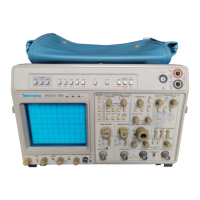Operation
Vertical
For voltage measurements, set VOL TS/DIV VAR fully clockwise. For best
accuracy, set
VOL TS/DIV for the largest display possible.
2-2
Input Coupling
Use
1
MO
DC
input mode for most applications. This mode
is
compatible
with the standard accessory, high-impedance probes
and
it displays logic levels
and
dc levels
of
static signals. Use the pair of buttons near the
CH
1 and
CH
2
inputs to select input coupling.
CH
3
and
CH
4 inputs
are
fixed at 1
MO
DC.
GND
input mode shows where the
O-volt
level will
be
displayed with
DC
coupling.
Use
AC
coupling for the special cases where
you
need
to
see
small
signals
on
large dc voltages.
Use
the
50
0
DC
input mode for the best possible vertical performance
with active probes,
50-0 signal sources,
and
low-impedance passive
probes. A low-impedance probe can present less than 2 pF load to the
signal-source,
in
parallel with 500 0 or 5000 0 with 10X or 100X
attenuation.
Input Conditioning for Video Signals
Video signals
can
be
distorted by
ac
coupling or by low-frequency
interference.
The
available Television/Video (TV) enhancement adds a TV
CLAMP to the
CH
2 input to eliminate such distortion.
To
use
the TV clamp:
1.
Apply a composite video signal to
CH
2.
2.
Select
CH
2 Trigger Source and set SLOPE to the displayed polarity of
the sync pulses.
3. Set the
CH
2 input to TV CLAMP by pressing the upper input-coupling
button for
CH
2 until the readout shows "TVC". The "back porch" of the
video signal will
be
locked to a fixed level.
Keep
the TV Clamp turned off when the trigger source
is
not composite
video or sync, to preserve normal operation
of
Channel
2.
Leave the rear-panel
CH
2 SIGNAL OUT unloaded to avoid a minor distortion
in
the video signal
when TV Clamp
is
on.
2465A/2455A/2445A Operators

